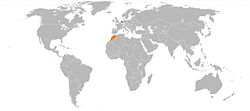- Morocco–Netherlands relations
-
Morocco – Netherlands relations 

Netherlands
MoroccoMorocco–Netherlands relations span a period from the 16th century to the present.
Contents
Treaty of Friendship and Free Commerce (1610)
From the end of the 16th century, the Netherlands had been attempting to establish friendly relations with Islamic countries, such as the Ottoman Empire and Morocco, due to their common enemity with Spain.[1]
Some meeger attempts took place under Ahmad al-Mansur until his death in 1603. In April-May 1605, Pieter Marteen Coy returned to Safi in Morocco and Algiers 135 Muslim captives, both Turkish and Moorish, who had been seized by the Dutch in a naval encounter with Spanish galleys. From 1605, Coy became representative of the States General in Marrakesh.[2]
From 1608, the new Moroccan Sultan Mulay Zidan, developed a Treaty of Friendship with the Low Countries, and sent several envoys there, such as Hammu ben Bashir,[3] Muhammad Alguazir, Al-Hajari and Yusuf Biscaino.[1][4] As a result of these exchanges, the Dutch are known to have sent 3 warships requested by Mulay Zidan.[1][3] Philip III of Spain used these military exchanges as one of the justifications for his expulsion of the Moriscos from Spain in 1609.[3]
A "Treaty of Friendship and Free Commerce" was signed between the two countries in December 1610, offering "free access and friendly reception for their respective subjects with any need for safeguard or safe-conduct, no matter how they come to the others' territory".[1][3]
In 1613 , Al-Hajari visited Holland, which he could visit freely due to the existence of a Treaty of Friendship. He stayed from June to September.[4] He discussed with the Dutch Prince Maurice of Orange the possibility of an alliance between Holland, the Ottoman Empire, Morocco and the Moriscos, against the common enemy Spain.[5] His book mentions the discussion for a combined offensive on Spain,[6] as well as the religious reasons for the good relations between Islam and Protestantism at the time:
Their teachers [Luther and Calvin] warned them [Protestants] against the Pope and the worshippers of Idols; they also told them not to hate the Muslims because they are the sword of God in the world against the idol-worshippers. That is why they side with the Muslims.—Al-Hajari, The Book of the Protector of Religion against the Unbelievers [7]Islamic studies
 Remains of the 19th century Dutch Consulate in Essaouira, Morocco.
Remains of the 19th century Dutch Consulate in Essaouira, Morocco.
Religious discussions also occurred. The early embassy of Hammu ben Bashi in late-1609 early-1610, led to the redaction of a polemical pamphlet about Christology entitled Inquisitio et responsio quae fuit inter Mahumetitsam et Christianum de Mesia ad intelligendum an ille sit filius Dei nec ne ("Investigation and its response, which has come about between a Muhammedan and a Christian in order to understand whether or not the Messiah is he son of God").[3]
One of the ambassadors, Yusuf Biscaino, met with Prince Maurice of Nassau who inquired to him about Islamic opinions on Jesus. He preferred not to answer on the spot, but later sent a letter to Maurice.[8] After returning to Marakesh, Yusuf Biscaino sent the letter in Latin to Maurice in 1611, relying as a source on the work of Muhammad Alguazir.[8]
One of the effects of these exchanges was the remarkable development of Arabic and Islamic studies in the Netherland, examplified by the work of Thomas Erpenius.[3] Thomas Epernius was able to advance his knowledge of Arabic through direct exchanges with Moroccan envoys, such as Al-Hajari.[3] Al-Hajara had used the Treaty of Friendship in order to visit the Netherlands freely after a sojourn in France.[3] Thomas Epernius became professor of Oriental Languages at Leiden University in 1613.[3]
Dutch embassy of 1640
 The walls of Marrakesh and El Badi Palace, by Adriaen Matham, 1640.
The walls of Marrakesh and El Badi Palace, by Adriaen Matham, 1640.
A Dutch embassy led by Antonius de Liedekerke visited the king of Morocco Mohammed esh Sheikh es Seghir in 1640. The embassy was accompanied by the engraver Adriaen Matham who left numerous drawings, including an engraving of the El Badi Palace, before it was destroyed.[9]
In 1644, Michiel de Ruyter visited the coast of Morocco and traded there extensively.[10]
Notes
- ^ a b c d Poetry, politics and polemics by Ed de Moor, Otto Zwartjes, G. J. H. van Gelder p.127
- ^ In the lands of the Christians: Arabic travel writing in the seventeenth century by Nabil I. Matar p.44 Notes 38-39
- ^ a b c d e f g h i Romania Arabica by Gerard Wiegers p.405ff
- ^ a b Romania Arabica by Gerard Wiegers p.410
- ^ The mirror of Spain, 1500-1700: the formation of a myth by J. N. Hillgarth p.210ff
- ^ In the Lands of the Christians by Nabil Matar, p.37 ISBN 0145932289
- ^ In the Lands of the Christians by Nabil Matar, p.37 ISBN 0145932289
- ^ a b European converts to Islam in the Maghreb by Mercedes García Arenal p.211
- ^ Marrakesh: The Secret of Courtyard Houses Quentin Wilbaux p.95ff
- ^ A History of the Jews in North Africa Haim Zeev Hirschberg, Eliezer Bashan, Robert Attal
 Foreign relations of Morocco
Foreign relations of MoroccoAfrica 
Americas Asia Europe Bulgaria · European Union · France · Greece · Netherlands · Norway · Portugal · Russia · Spain · Turkey · United KingdomWestern Sahara conflict Related topics Moroccan Ministry of Foreign Affairs  Foreign relations of the Netherlands
Foreign relations of the NetherlandsAmericas and Asia China · Canada · Indonesia · Israel · Japan · Malaysia · Texas (historical) • Suriname · United States
Europe Africa Morocco · South AfricaRelated topics Dutch Ministry of Foreign Affairs Categories:- Bilateral relations of Morocco
- Bilateral relations of the Netherlands
Wikimedia Foundation. 2010.



